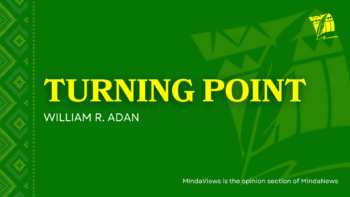An upcoming documentary film festival presented by GMA News TV will be featuring works of two Mindanawon filmmakers.
Filmmaker, editor, and writer Charliebebs Gohetia is one of them. His documentary for Cine Totoo is one of the 11 that will be screened on September 24 to 30 in SM Megamall, SM Manila, and Trinoma Mall Cinemas.
His career started in 2006, while still in film school, when he edited the debut of then upcoming director Brillante Mendoza. The film was “The Masseur.” He then edited Mendoza’s subsequent films, including “Tirador” (Slingshot) in 2007, which made him the first Filipino to be nominated at the 2nd Asian Film Awards in Hongkong.
His works have competed in major international film festivals such as Cannes, Berlin, Toronto, Locarno, among others.
In 2008, he wrote, produced, edited and directed his debut, “The ‘Thank You’ Girls,” a comedy about traveling gay beauty queens, which first competed at the Dragons and Tigers Competition at the Vancouver International Film Festival. It was also screened at the Chicago International Film Festival and Calgary International Film Festival. The film became a cult hit in the Philippines and had theatrical screenings in US and Canada
In his Cine Totoo documentary “Kung Giunsa Pagbuhat Ang Binisayang Chopsuey,” Gohetia follows a Tchoukball team that comprises a diverse set of individuals: former drug runners, children in conflict with the law, Pastors, working professionals, businessmen, out-of-school youth and homosexuals.
In this interview, Gohetia talks about why he makes films, how he hurdles through filmmaking challenges, and what he is most excited to share about.
What is your film philosophy?
To make good films—those that people will remember and cause impact in their lives. I make films that will stand the test of time—those that will still be relevant even after decades.
What stories about Mindanao do you want tell?
I cannot list specific stories because there are a lot of facets of Mindanao that I have yet to discover. I am in the process of continuing to learn what Mindanao and its people are all about and I am looking forward to have a deeper understanding of my heritage. Whatever I’ll discover, I can’t wait to share these stories through films.
How do you overcome the challenges that you face in filming?
Prepare, adjust, deliver. The best way to overcome the challenges of filmmaking is to prepare–know your constraints and find ways to make up for it. That’s what preproduction is for. I prefer troubleshooting the dirty work and dealing with logistical and creative nightmares during preproduction than getting confronted by it during principal photography. Knowing your constraints, a filmmaker must know how to adjust. Filmmaking is a long process, it can be taxing but at the end of the day, you are judged by your output. A filmmaker should know to deliver his vision.
What things do you discover about yourself when you film stories of others?
Documentary is much harder to do than fiction. Every shooting day is a challenge, you’re always confronted by unforeseen circumstances and you have to be ready for it. You’re faced with ethical issues (like knowing your boundaries and which aspect of your subject’s stories to show or not). I learned to be more patient, letting things flow by themselves, letting the subjects take you to their ride, instead of me (as a director) controlling everything. I shoot documentaries as natural as possible, I don’t do sit-down interviews nor reenactments. I want to capture events as they happen and I’ve learned that every story is unique.
Which character in your Cine Totoo documentary did you find to be the most compelling?
I originally had five to six characters for the documentary and I originally intended to follow them throughout the whole process but I had to drop two or three of them because schedule and some stories and angles might not work in the whole storyline. I think “Kung Giunsa Pagbuhat ang Binisayang Chopsuey” is the story of the whole team and despite being told through the perspectives of many characters. And the whole group has a compelling account of its own that is threaded through the documentary’s story.
What’s on your filmmaker kit?
A filmmaker’s most important accessory should be his script. And lots of preparation. I am uneasy whenever I go to the set unprepared, it’s like being in an impromptu firing squad. Doing a film takes a lot of psychological, emotional and financial preparation. So unless I’m ready to embark on a new journey of doing a film, I won’t do it.
What runs around your head whenever you edit a film?
Depends on whose film I’m editing. If it’s another filmmaker’s film, I need to know his/her vision and what he/she wants for the output. It’s much harder to edit my own film because I have to separate myself from being its writer, producer, director.
What’s the most interesting feedback that you’ve ever heard from an audience?
The audience telling me after the screening that the film is already their favorite film or that they are inspired to venture into filmmaking after seeing the film. In the case of my second film, “The Natural Phenomenon of Madness,” people confess to me that they continue to find themselves being disturbed by the film after days or weeks of watching it.
Name five films that heavily influenced yours.
Run Lola Run by Tom Tykwer tops my list. After I’ve seen it the first time during my freshman year in film school, I thought I wanted to be Tom Tykwer when I grow up. Christopher Nolan and his films “Memento” and “Following”. Alejandro Inarritu (21 Grams and Amores Perros). Requiem for a dream by Darren Aronofsky. I was affected by Wong-Kar Wai and his films “Chungking Express” and “Happy Together”. I always love films that are unconventional, defying the norm and stereotype. My dream is to do a romantic comedy film, the likes of “My Sassy Girl” by Kwak Jae-yong. (Jesse Pizarro Boga/MindaNews)
